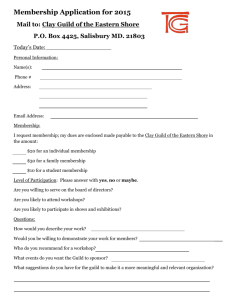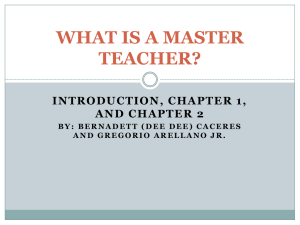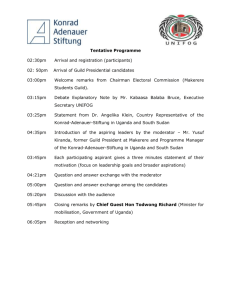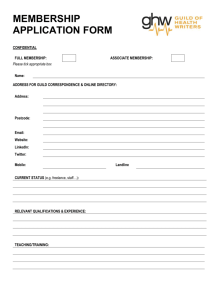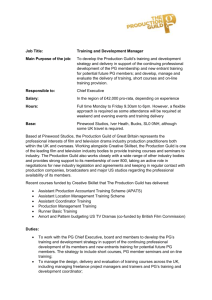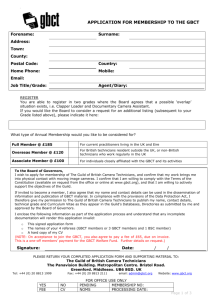File - West Essex & East Herts Guild Spinners, Weavers
advertisement
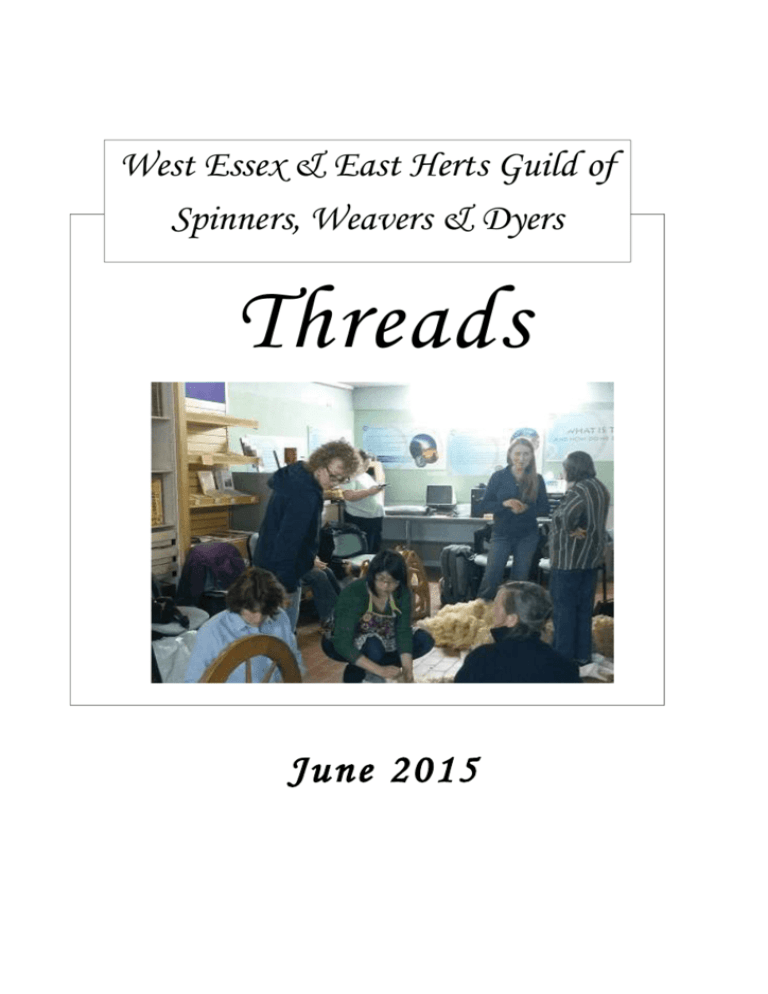
West Essex & East Herts Guild of Spinners, Weavers & Dyers Threads June 2015 Members of the Committee 2014/15 Chair Carolyn Green Vice-Chair Lesley Ottewell Secretary Mary Hicks Treasurer Cate Barnett Publicity Officer Asela Ali Programme Secretary Sue Prior Committee Member Chris Lane Guild Website www.westessexeasthertswsd.weebly.com Guild Programme 2015 th Saturday 11 July 10am – 4pm Dyeing workshop- Shibori scarf project Bell House, Bell Lane, Widford 35th Anniversary picnic Saturday 8 August 10.004.00 p.m. Spinning in the Museum Gardens Harlow Museum Saturday 12 September 10.00 a.m.-4.00 p.m. Knitting Workshop with Juliet Bernard Harlow Museum Continental knitting, mosaic techniques and Q&A session Thursday 8 October 7.009.00 p.m. Annual General Meeting and Competition: Harlow Museum “50gms Odd Ball” – Make anything from 1 ball in your stash We look forward to seeing you soon Notes on Herdwick sheep. By Mary Jackson Vikings brought this hardy breed to the Lake District, and Beatrix Potter was instrumental in saving them. There are about fifty thousand, all within fourteen miles of Coniston. Able to survive under snow by eating their own wool, defying persistent rain on mountains, living on forage, and being hefted to their own area, they were unable to counter foot and mouth disease, a quarter being lost. The grey ewes bear one black lamb, which after the first shearing turns grey. The tough wool, once used for carpets, fell in value to a penny a fleece, at which point the National Trust took over, and now buys and markets it, often as fireproofed loft insulation. Made into garments the bristles form a second layer which can protect from a blizzard. It is not easy to dye. However, if you do manage to make a jumper of it and then become buried under snow, you can always eat it ! Shibori Dyeing Project When we started to weave the silk for the shibori dyeing project, I was quite confident as I had had quite a bit of practise at using pick-up sticks. However, when Chris encountered a problem when changing her pattern, I was a bit non-plussed as I could not see what the problem was. The next day I carried on with the weaving. I changed the pick-up pattern after each set of five blocks, which became a real pain quite quickly. As someone who loves short cuts, I devised this simple strategy. To change the pattern: Set the heddle to the DOWN position. Leave the pattern stick in position. Use a strip of card to make a new pattern beyond the stick. As the card is flexible it is easier to manoeuvre it between the warp threads. Remove the stick. Slide the stick over the card to take up the new pattern. Remove the card. Part way through the weaving, I decided to re-read the printed notes. I had vaguely remembered that it had shown a photo with the pick-up pattern showing on both sides, which mine did not. So when I finished the first scarf, I made a second one with the pick up threads appearing first on the top and then on the underside of the weaving. To weave the pattern on both sides of the fabric: Weave the pattern on the upper side of the cloth. Weave a few rows of plain weave. Raise the heddle to UP and slide the pattern stick forward but keep it flat. Count your rows as you will not be able to see the pattern but he pattern thread will be visible at the sides of the weaving. Warning! Take care when using the pattern stick. Keep it back, when not in use. If your pattern stick slides forward during your plain weave, you may get pattern threads on the underside, which will be in your main weft thread and will therefore be present after the pulled up threads have been removed. Tip I always find it irritating to have so much wastage at the end of my weaving, particularly as I usually use the Ashford method of warping up. The way they go through the slots does not always correspond to the way they come off the back. To weave further up the warp: Set the heddle to UP Put the pattern stick through the shed and push it as far back as possible. This keeps the warp threads in the correct position for much longer. by Lesley Ottewell An exciting new exhibition of contemporary tapestry weaving from the British Tapestry Group). The exhibition aims to show what tapestry is and what it can encompass. Often mistaken for needlepoint, hand woven tapestry is the art of using weft-faced weaving to express a range of images, emotions and ideas in material form. Whatever you thought tapestry was, prepare to be surprised and amazed. For further information, email Tim Oelman at: tapestryinfo@aol.com BOOK REVIEW by Mary Jackson Baskets and Belongings: Indigenous Australian Histories By Lissant Bolton ISBN 978 0-7141-2599-2 Priced at £9.99 Recently I visited an exhibition at the British Museum, the subject of which was Aboriginal Art of Australia. In 2011 there was another exhibition with some of the same materials called Baskets and Belongings: Indigenous Australian Histories, which unfortunately I missed. However I managed to buy the book, the illustrations for which are stunning. Here are some thoughts from the text: “These baskets, used to carry important or personal belongings and to hold food, reflect the specific connection of different indigenous groups to their landscapes and territory. Baskets belong: to places, to people, to stories... ...some indigenous groups made wooden dishes and bowls, bark baskets and folded palm spathe baskets... Most groups have also made various kinds of string and looped net bags... Baskets can be made from many different kinds of materials, such as cane, grass, sedges, rushes, reeds, spinifex, flax, vines, pandanus, and bark. In order to use these fibres people need to have a detailed knowledge of the landscape and the seasons, harvesting materials when it is most suitable for them to be worked: even the time of day and the degree of humidity can affect the flexibility of natural fibres. Many different techniques, often specific to certain areas, have been employed to make baskets, including twining, coiling, plaiting, knotting and looping..." The author explains the different mind-set of the aboriginal inhabitants who worked in tune with their environment, compared with the exploitative white settlers. To the aboriginal culture, buying and selling land was a foreign concept, verging on the blasphemous. Exhibitions and books like these go some way to bringing a better understanding of Australian Aboriginal society. The book is a delight to read and its 100 colour illustrations are absorbing, even moving. 60th Anniversary Challenge The national association is celebrating 60 years and have asked Guilds to knit and donate to Knit for Peace (featured in Threads, Dec 2014). As a local guild with as many different interests, skills, cultures, and backgrounds as breeds of sheep; we have decided to appreciate our diversity and benefit a number of charitable causes. Chris has kindly researched Loving Hands and we are asking members to look on their website and choose one charity and and an item to make for them. We would like you to take a picture of the finished item / item in progress and let us know why you picked that charity for Threads. http://www.lovinghands.org.uk/wish-list/4589437245 Even if you don’t have a particular cause that interests you, there are a variety of items that are always needed that you may just enjoy making…. Trauma Toys Toys of all sorts 8" to 10" in size. These are used by ambulance and fire crews to give to children who are caught up in accidents etc. For the Elderly Bed Jackets, Bed Socks, Blankets, Cardigans, Gloves, Hats, Hot water bottle covers, Jumpers, Lap Rugs, Mittens, Scarves Maternity Units in sizes from 10" to 18" Blankets (15" to 26"), Bodywarmers, Bootees, Cardigans, Hats Mitts, Shawls, Small Toys, Angel Pockets, Burial Gowns Receiving Blankets Animal Shelters Blankets (from small 15" squares for cats, to warmers for large dogs) Dog Coats (for dogs who are recovering from illnesses and hair loss) For Seafarers Hats, Balaclavas, Fingerless Gloves, Scarves Taken to the boats by chaplains from Apostleship of the Sea As an example, one of our members knits/crochets a blanket for REFUGE each year. She purchases acrylic yarn from charity shops and then practises different stitches as 6 inch squares which then get joined and sent to the charity. These blankets are for women and children fleeing domestic abuse with very little and often no time to pack anything. It is the first thing given as they walk through the door as a comfort which they can take with them. She chose this charity because she has been in those running shoes and feels it is her way of saying thank-you. The West Essex & East Herts Guild of Spinners, Weavers & Dyers Minutes of Committee Meeting held on Wednesday 22 April 2015 at 6.30 p.m. at Cate’s Present: Carolyn Green - Chairman Lesley Ottewell - Vice-Chairman Mary Hicks - Secretary Cate Barnett - Treasurer Asela Ali - Publicity and Threads Editor Sue Prior - Programme Secretary Chris Lane - Committee 1. Apologies for Absence – None, everyone present. 2. Minutes of Previous Meeting held on 14 March 2015 were signed by Carolyn as a true record. 3. Matters For Discussion - Venues 3.1 Carolyn tabled correspondence with Justin Hopwood, Pets Corner Manager. They are currently redeveloping and, realistically, new buildings are unlikely to be available before the autumn. Carolyn agreed to respond saying we were interested and would keep in touch. 3.2 There was further discussion of the fees being charged by Harlow Museum. Mary agreed to contact Science Alive to discuss the possibility of a reduction, particularly for Saturday meetings. 3.3 The possibility of using Gilston Village Hall as a stop-gap was considered but this is in use on Thursday evenings, as is High Wych Village Hall. 4. Arrangements for Future Meetings 4.1 The May meeting would include tips on fleece sorting, hand-carding and washing. Raw fleece to be provided by Cate (Teeswater) and Asela (Suffolk), and washed fleece by Sue. Sheets would be needed to protect the floor. A variety of carders would be useful. 4.2 Sue had previously mailed members (10 Feb) about Paula Armstrong’s talk and mini-workshop for June, and would send reminder nearer the time. 4.3 Pat was happy to host the July dyeing day and would charge £5 for lunch. The indigo vat would probably need reactivating. 4.4 The August meeting would include a shared picnic lunch in celebration of the Guild’s 35th anniversary. Everyone to bring lunch to share. Lesley offered to make a cheesecake and Asela offered to bring a celebration cake. 5. Outside Events Mary had written to Forty Hall setting out our proposal and would chase up. Confirmation was needed of set-up time and an inside location. Carolyn had already produced a number of ‘fill the gap’ kits but the organisers had specified that we needed to cater for up to 100 children. Programmes should be available and Asela felt she could take a laptop to show the Guild website. 6. Association AGM and 60th Anniversary 6.1 Mary and Cate had attended the AGM in London on Saturday 18 April when the Association suggestion for each Guild to produce a dressing gown as part of the Knit for Peace project to mark the 60th Anniversary was again raised. 6.2 Chris tabled details of several causes requesting various small items, e.g., trauma teddies, little yellow ducks, etc. It was suggested that every member choose an item they would like to produce (instead of a Guild dressing gown!) as a response to the Association challenge. 6.3 The Association had also set Guilds the challenge of ‘doing something different next year’. 7. Programme 2016 7.1 Previously suggested topics/speakers were: 1. Talk by Matty Smith, tapestry weaver and/or Weavers Bazaar visit 2. Procion dyes workshop with Michele Turner 3. Visit and talk from Nancy Lee Child 4. Beaded braid jewellery 7.2 It was agreed that the 2016 Competition would be another ‘Dye-a-bundle’ challenge. 7.3 It was also agreed that there would be a Guild outing in place of the July meeting, possibly to Jason Collingwood’s studio at Nayland, Essex. 8. Finance Cate reported healthy balances as follows: Current account £1286.85 Deposit account £1007.65 Cash-in-hand £138.90 9. Any Other Business None 10. Date of Next Meeting This would be held during the Guild Meeting on Saturday 11 July. The Kendal Pattern Book At the AGM in April the Lancs & Lakes Guild presented every Guild in the Association with a complimentary copy of their Kendal Pattern Book. The inspiration for this amazing publication is a small leather-bound volume fished out of a bin by a rather enlightened refuse collector. It has just 38 pages containing 498 samples of Linsey-Woolsey hand woven fabric from the years 1769-1774, grouped in 22 styles and patterns. The fabric was used to make every day 18th century work clothing. The Lancs & Lakes Guild managed to secure funding to stage an exhibition in honour of this astounding find, together with a reworking of some of the designs from the original book. As 2009 was the Guild’s Golden Jubilee, they decided also to reproduce the patterns in a book with details of how they went about the task. So now we have a copy of our own for our library. The book will also be for sale at £15 + p&p. To express interest e-mail: lancsandlakeswsd.gmail.com They will only order a print run if sufficient interest is shown. Calendar of Events Sun 12 July Little Berkhamsted Arts & Craft Fair 25- 26th July Fibre East, Redborne School & Community College, Bedford Sun 26 July 12.00-4.00 Great & Little Hallingbury Flower & Country Show Sun 2 August K9 Dog Show, South Woodham Ferrers Sat 29 August Epping Horticultural Society Annual Show, St John’s Church, Epping Sun 30 August Samoyed Rally, Potton End Sun 13 Sept Autumn Craft Fair, Mill Green Museum … and finally, The Guild competition this year is make anything from a 50g ball. It’s a great way to use up your stash / impulse buy…or (in my case), the hand-dyed that was more surprising than expected! If you are stuck for ideas have a look at http://www.allfreeknitting.com/tag/Stashbuster If you would like to contribute to the next edition of Threads or would like to add some information to our website, please contact Asela Ali at palmsnpeacocks@gmail.com *** Lead Workshops will need to be booked through our Treasurer and paid for in advance. *** If you would like to propose a speaker or workshop or would like us to come and demonstrate, please contact our Programme Secretary. *** To borrow equipment or books from the Guild library please contact a member of the committee. *** Monthly meetings at Harlow Museum Muskham Road CM20 2LF
